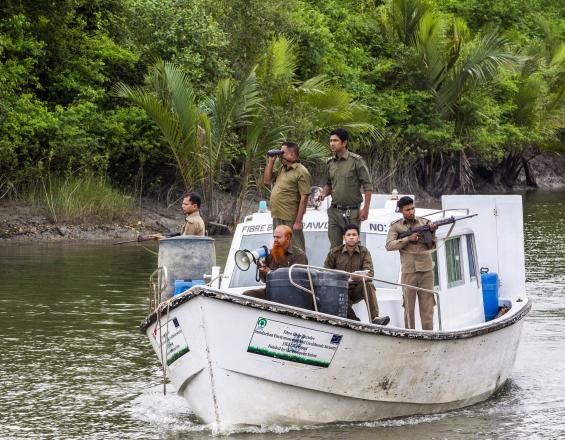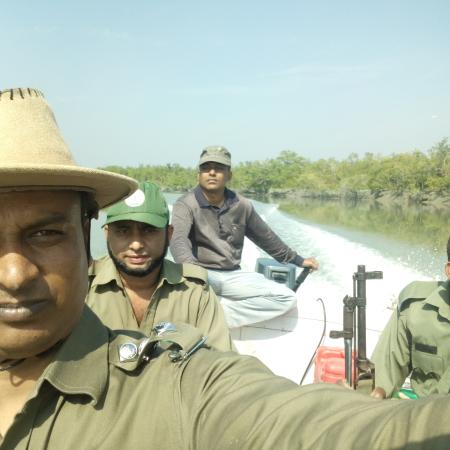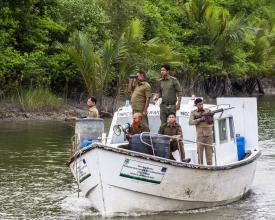
Outil de surveillance spatiale et de rapport (SMART) pour une application efficace de la loi et une surveillance de la faune dans la forêt de mangrove des Sundarbans, au Bangladesh

SMART (Spatial Monitoring and Reporting Tool) est un système de collecte de données et de rapport basé sur des preuves pour la surveillance de l'application de la loi sur la faune et la forêt. SMART est une combinaison de logiciels, de matériel de formation et de normes de mise en œuvre pour l'application systématique de la loi et les patrouilles de surveillance. SMART est conçu pour améliorer les efforts de lutte contre le braconnage et l'efficacité globale de l'application de la loi dans les aires de conservation et les zones de gestion établies. Depuis juin 2016, en collaboration avec la Wildlife Conservation Society, le Sundarbans Management Project SMP (mis en œuvre conjointement par la GIZ et le Département des forêts du Bangladesh et financé par le gouvernement fédéral allemand) a lancé des patrouilles SMART dans l'ensemble des Sundarbans. Le SMP a lancé des efforts de développement des capacités avec un développement des compétences de base et avancées du personnel individuel du BFD sur l'application de SMART, l'analyse des données, la génération de rapports, l'interprétation des résultats, ainsi que l'établissement de protocoles standard pour la pratique des patrouilles SMART dans les Sundarbans.
Contexte
Défis à relever
Le braconnage de la faune, la pêche à l'aide d'engins illégaux, l'abattage illicite d'arbres sont les plus grands défis à relever dans les Sundarbans. Les patrouilles forestières traditionnelles n'ont pas été en mesure de produire les informations de qualité attendues sur les observations et les menaces. Il était également difficile pour les gestionnaires de contrôler les efforts de patrouille de leur personnel. Les informations générées par les patrouilles traditionnelles n'étaient pas non plus suffisantes pour être utilisées dans le cadre d'une gestion adaptative. Les capacités/compétences limitées du personnel de première ligne et le manque de connaissances sur les lois/règles applicables n'ont pas permis d'obtenir les résultats escomptés des patrouilles. Une gestion très complexe des ressources dans les Sundarbans avec des dispositions d'interdiction saisonnière, d'interdiction d'espèces, d'interdiction de zones, etc. rend la situation encore plus difficile pour le personnel de première ligne.
De plus, des données inadéquates (points chauds de la criminalité forestière et de la biodiversité, base de données des délinquants), l'absence de protocoles de patrouille normalisés, de registres numérisés et de dispositifs de collecte de données, ainsi qu'une logistique et des allocations inadéquates ont empêché la planification et la mise en œuvre réussies des patrouilles.
Emplacement
Traiter
Résumé du processus
Le SMP a normalisé les protocoles SMART pour les Sundarbans, y compris les procédures opérationnelles, les modèles de données harmonisés, les programmes de formation sous la forme d'un manuel approuvé par le gouvernement, tout en déployant des efforts continus pour renforcer les capacités du personnel du BFD en matière de patrouilles, de collecte de données, d'analyse et d'établissement de rapports, et a finalement intégré les résultats dans le processus décisionnel en vue d'une gestion adaptative. Le gouvernement est resté très convaincu et s'est engagé à faire ce qu'il fallait pour assurer son succès depuis les efforts de pilotage dans les Sundarbans. Le BFD a fait de SMART un outil de gestion adaptative et envisage de l'introduire dans toutes les zones protégées du pays. Les engagements du gouvernement, les protocoles standardisés et les efforts continus de renforcement des capacités ont collectivement interagi et construit les bases d'un enrôlement réussi des patrouilles SMART dans les Sundarbans et ont fourni des indications sur la gestion adaptative.
Blocs de construction
Manuel SMART comprenant les procédures opérationnelles SMART (SOP)
Le manuel SMART a été élaboré conjointement avec le BFD et comprend des contributions précieuses de la part des membres du groupe de travail SMART de plusieurs parties prenantes. Le SOP constitue une étape cruciale et présente un cadre uniforme et pratique pour la mise en œuvre de SMART dans les Sundarbans. Les dispositions qui ont été incorporées dans le SOP et le Manuel sont conformes aux lois et règlements du "Gouvernement du Bangladesh". Tout le personnel impliqué dans les patrouilles SMART a reçu une formation sur le "Manuel SMART" et le "SOP" et tout le monde possède une copie papier de ces documents. Cela les aide à se guider pendant les patrouilles.
Facteurs favorables
Une forte coopération entre les différents partenaires de développement et la BFD a permis de créer un environnement de travail commun parfait ;
La formation du groupe de travail technique SMART, avec la participation de tous les partenaires de développement actifs, a permis de fournir des contributions d'experts et de suggérer des orientations ;
La volonté de la BFD d'apporter son expertise technique et de développer des protocoles à l'épreuve du temps pour les Sundarbans.
Leçon apprise
Les résultats (manuel, SOP) sont largement acceptés grâce à l'engagement de toutes les parties prenantes potentielles ;
Processus long et travail acharné.
Engagement et soutien du gouvernement à l'égard de SMART
Le BFD était à la recherche d'une option efficace d'application de la loi sur la conservation qui serait également pratique et abordable dans le contexte des Sundarbans. Les bons résultats obtenus par les initiatives pilotes ont incité la BFD à procéder à une mise en œuvre à grande échelle dans les Sundarbans. Cependant, la mise en œuvre indépendante mais efficace de SMART a été un grand défi puisque BFD dépendait uniquement de soutiens externes (c'est-à-dire de projets). L'approche du SMP consistant à développer un pool de maîtres-formateurs pour SMART, à les utiliser pour former le personnel de première ligne, à développer des gestionnaires et des analystes de données, a fortement motivé le BFD pour un déploiement plus indépendant de SMART dans les Sundarbans.
Le BFD a pris conscience de ce besoin et a réagi rapidement en élaborant des protocoles SMART standard pour les Sundarbans, en collaboration avec les développeurs et les parties prenantes concernées, et en les mettant en pratique. Avec l'approbation du SOP, du manuel et d'autres documents connexes, le BFD a mis en place les instruments juridiques nécessaires à son bon fonctionnement. Il a également maintenu un flux de fonds soutenu pour répondre aux besoins en logistique et en carburant afin de maintenir SMART opérationnel.
Facteurs favorables
- La BFD a été très convaincue par l'approche et les normes SMART ;
- Un leadership jeune, dynamique et positif au niveau des Sundarbans a aidé le BFD à définir sa vision à long terme et à concevoir les avantages potentiels de SMART ;
- Le gouvernement, à son plus haut niveau, a montré son engagement envers la conservation des Sundarbans et est prêt à faire tout ce qui est nécessaire.
Leçon apprise
N/A
Renforcement des capacités
Un matériel de formation complet a été élaboré et fourni pour soutenir les formations SMART. Les capacités du personnel de première ligne du BFD ont été renforcées pour mener à bien les patrouilles SMART sur le terrain et la manipulation des équipements et gadgets nécessaires. Trois efforts de formation différents ont été mis à disposition
- Formation des formateurs SMART - certains membres du personnel de niveau intermédiaire du BFD ont été formés, en faisant appel à des facilitateurs expatriés, aux compétences de base et avancées en matière de patrouilles SMART, à l'aide du matériel de formation mis au point ; les 41 meilleurs formateurs ont été identifiés et désignés comme "maîtres formateurs".
- Patrouilles SMART de base - Les "maîtres formateurs" ont formé (en présence et avec le soutien de facilitateurs expatriés) 125 membres du personnel de première ligne du BFD aux compétences de base des patrouilles SMART, ont effectué des patrouilles de démonstration, ont manipulé physiquement des gadgets et des équipements et sont ensuite devenus actifs au sein de l'équipe de patrouille.
- Gestion des bases de données SMART - 31 agents du BFD ont été formés au nettoyage des données, à l'édition, à l'analyse, à la production de rapports et à l'interprétation des résultats. Des membres du personnel sélectionnés ont également reçu une formation avancée à la gestion des données.
Les équipes de patrouille SMART dans les Sundarbans ont été accompagnées par des mentors embarqués dans des patrouilles sélectionnées et ont aidé à surmonter leurs problèmes sur place, notamment en ce qui concerne l'utilisation d'un système de positionnement global (GPS), la navigation, les patrouilles en bateau et à pied, l'application de la loi, l'amélioration de la collecte des données et l'assurance de leur qualité.
Facteurs favorables
- Critères de sélection des participants : niveau d'études, jeunes/énergiques, enthousiastes,
- Les membres du personnel les plus performants et ayant fait leurs preuves ont été sélectionnés pour le programme SMART.
- Un grand nombre d'agents possèdent les capacités minimales requises pour suivre ces formations et utiliser le système SMART.
- Les membres du personnel ont une grande expérience des patrouilles.
- Les nouvelles recrues du BFD ayant de bonnes connaissances en informatique ont contribué à la gestion et à l'analyse des données.
Leçon apprise
- Transfert/rotation fréquents du personnel au sein du BFD
- positif - du personnel formé serait utile pour le déploiement national
Déployer des patrouilles SMART sur le terrain
8 équipes formées pour les patrouilles SMART dans 4 massifs forestiers des Sundarbans. Un navire-mère, un chalutier à fibre (pour les patrouilles dans les canaux et les criques) et un hors-bord pour se rendre dans les zones où le chalutier ne peut accéder en raison de la faible largeur du canal/de la crique et de la faible profondeur de l'eau, ainsi que pour poursuivre les contrevenants. Sous la direction d'un chef d'équipe, chaque équipe reste sur le terrain pendant 10 à 14 jours et patrouille les points chauds de la criminalité, enregistre les observations d'espèces sauvages clés, les activités illicites, vérifie les permis et les documents nécessaires, les gadgets/armes des pêcheurs, arrête les contrevenants, remet les contrevenants aux bureaux forestiers voisins, enregistre toutes les données dans le modèle de données configuré dans l'appareil portable (c.-à-d. CyberTracker).
Une fois l'excursion terminée, l'équipe remet son appareil portable au "gestionnaire de données" pour qu'il vérifie la qualité des données et les décharge dans la plateforme de stockage des données. Le chef d'équipe rédige également une note d'information à l'intention de l'équipe de patrouille suivante, en soulignant les zones de couverture, les points chauds potentiels en matière de criminalité et la direction à donner à l'équipe de patrouille suivante. Les données nettoyées sont ensuite transmises au "coordinateur des données", qui compile les données des quatre rangées, les analyse et génère des rapports présentant les résultats sous la forme de différents graphiques, montrant les tendances, les points chauds, les informations sur les délinquants et les personnes arrêtées, etc. et les présente au comité d'application de la loi SMART pour faciliter la prise de décision et la gestion adaptative.
Facteurs favorables
- Comité d'application SMART fonctionnel - engagement du groupe de travail technique (DP) en tant qu'observateur
- SOP et manuel - moins de risques de malentendus/confusions puisque toutes les dispositions et arrangements ont été documentés, convenus et approuvés.
- Le mentorat à bord a permis d'aborder minutieusement les problèmes de chaque membre du personnel et d'améliorer leur capacité à utiliser les gadgets ;
Leçon apprise
Des effectifs supplémentaires sont nécessaires, en particulier pour la gestion et l'analyse des données.
Gestion adaptative
Le BFD a commencé à utiliser SMART comme outil de gestion adaptative dans les Sundarbans, ce qui constitue l'un des principaux avantages potentiels de l'approche.
La présentation des rapports au comité d'application de SMART a aidé les décideurs du BFD à planifier les patrouilles sur la base des requêtes de données et des interprétations des rapports SMART actuels. Ceci, avec les observations de mentorat à bord, a aidé les décideurs du BFD à prendre d'autres décisions de gestion.
Le BFD utilise les rapports de patrouille SMART et évalue la manière dont les plans de patrouille ont été adaptés sur la base des résultats des patrouilles précédentes et dans quelle mesure ces adaptations ont permis d'accroître l'efficacité des patrouilles SMART, comme en témoignent la zone couverte, le nombre d'arrestations et de poursuites judiciaires réussies à l'encontre de criminels commettant des délits graves liés à la faune, à la pêche et à la forêt, tels que le braconnage et la pêche au poison ; les confiscations de bateaux, d'armes, de collets et de pièges, de carcasses d'animaux sauvages et de parties de corps ; et les tendances (augmentation, stabilité ou diminution) des taux d'observation des principales espèces sauvages menacées.
Facteurs favorables
Sensibilisation des gestionnaires à la gestion adaptative et au rôle des données SMART dans ce domaine
Leçon apprise
Le BFD doit renforcer les capacités des gestionnaires à utiliser les données SMART et à projeter/prévoir les changements/tendances et à incorporer des mesures prospectives en faveur de la conservation.
Impacts
SMART (Spatial Monitoring and Reporting Tool) est un système de collecte de données et de rapport basé sur des preuves pour la surveillance de l'application de la loi sur la faune et la forêt. SMART est une combinaison de logiciels, de matériel de formation et de normes de mise en œuvre pour l'application systématique de la loi et les patrouilles de surveillance. SMART est conçu pour améliorer les efforts de lutte contre le braconnage et l'efficacité générale de l'application de la loi dans les aires de conservation et les zones de gestion établies. Les patrouilles SMART ont été expérimentées dans une partie de la chaîne Satkhira des Sundarbans. Depuis juin 2016, en collaboration avec la Wildlife Conservation Society (WCS), le Sundarbans Management Project - SMP (mis en œuvre conjointement par la Deutsche Gesellschaft für
Internationale Zusammenarbeit (GIZ) GmbH et le Département des forêts du Bangladesh - BFD et financé par le gouvernement fédéral allemand) a lancé des patrouilles SMART dans l'ensemble des Sundarbans. Le SMP a entrepris des efforts de développement des capacités en développant les compétences de base et avancées du personnel du BFD en ce qui concerne l'application de SMART, l'analyse des données, la production de rapports, l'interprétation des résultats, ainsi que l'établissement de protocoles standard pour la pratique des patrouilles SMART dans les Sundarbans.
Bénéficiaires
Personnel de première ligne du département des forêts du Bangladesh, gestionnaires d'aires protégées et utilisateurs des ressources
Objectifs de développement durable
Histoire

M. Belal Hossain a rejoint les forêts réservées de Sundarbans le 19/09/2016 en tant que forestier sans avoir la moindre idée des patrouilles SMART. Il a immédiatement été affecté à la station Burigolaini de la chaîne Satkhira de la division ouest des Sundarbans en tant qu'agent de station.
Il a reçu sa première formation de base sur les patrouilles SMART (Spatial Monitoring and Reporting Tool) en juin 2017 dans le cadre du projet de gestion des Sundarbans (SMP) mis en œuvre conjointement par le BFD et la GIZ. Il a rejoint sa première patrouille SMART dans les Sundarbans en tant que chef d'équipe de l'équipe de patrouille SMART -2 de Satkhira en janvier 2018. Depuis lors, il a dirigé 4 équipes SMART dans les Sundarbans et a passé plus de 40 jours en patrouille SMART dans les Sundarbans. Mais le changement majeur dans sa carrière a eu lieu en juillet 2018 lorsqu'il a assumé le rôle de coordinateur des données SMART pour l'ensemble de la SRF. Le coordinateur des données SMART pour la SRF est chargé d'examiner et de compiler toutes les données de patrouille exportées ; de rédiger un rapport mensuel combiné sur les patrouilles SMART pour l'ensemble de la SRF avec des recommandations ; de présenter le rapport mensuel SMART devant le comité d'application SMART et, après la finalisation du rapport SMART, de stocker tous les documents (copies papier et électroniques).
Depuis lors, M. Hossain a déjà rédigé et finalisé 20 rapports mensuels SMART et 2 rapports annuels SMART pour l'ensemble de la SRF. Actuellement, M. Hossain poursuit son rôle de coordinateur des données SMART pour la SRF, en plus de sa fonction principale d'agent de la station forestière de Kobadak et de chef de l'équipe de patrouille SMART de Satkhira -2.
"Travailler avec SMART m'a donné la confiance nécessaire pour mener à bien de multiples tâches avec efficacité et a considérablement amélioré mes compétences en matière de présentation. La recherche et le traitement des infractions sont devenus plus faciles dans les Sundarbans avec l'introduction de SMART", a déclaré M. Hossain lorsqu'on lui a demandé quelle était la principale contribution de SMART à sa carrière. M. Hossain est maintenant un forestier très confiant et a reçu plusieurs autres formations de SMP et d'autres projets du BFD, y compris une visite d'exposition en Inde.






